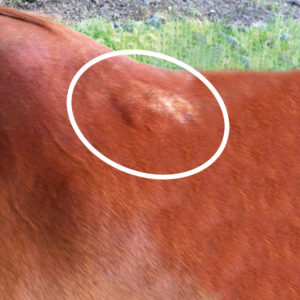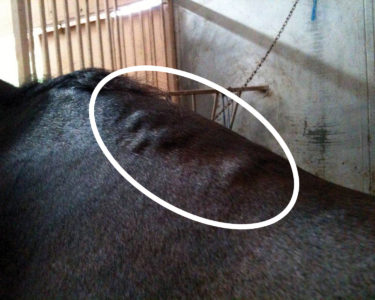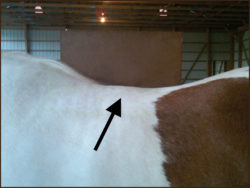Saddle Fit and Bumps and Blisters
I often come across this issue when I am fitting saddles. I have included a couple of pictures of various horses that I have worked with – all of whom developed these funny looking bumps or blisters after I fitted their saddles! That was always really strange to me, until I actually researched the phenomenon and spoke to several veterinarians about the causes and reasons behind these irregularities.

Fluid bumps can develop when the horse is ridden hollow and the transverse processes of the spine touch each other or rub (as in kissing spine), or the withers are not in alignment with the spine. Fluid bumps can also come when the ligaments have been injured previously from saddles with gullets that were too narrow.
A saddle that sits on the shoulder and on the ligaments of the spine (instead of behind the shoulder and on the muscles of the saddle support area), will carry most of the rider’s weight on the cartilage of the shoulder and on these spinal ligaments (as previously explained in my blog on the two divergent theories of saddle fit). The fluid does not develop if you press on the injured ligaments or on the spinal transverse processes, since the horse is being impeded from its full range of motion by the placement and pinching of the saddle. Therefore, the false assumption may develop that it is better to have the saddle sitting on the spine and shoulders as then there are no bumps and the horse does not show discomfort. This is only temporary respite, as deformity has not set in yet. All the while the muscles are get tenses and the wrong muscles are getting trained (resulting in what we call “upside down” training).

To properly answer why and how these blisters develop, we have to go into a little scientific/medical detail to explain the process. Often, it is a poorly fitting saddle that causes a problem known as ‘ischemia’ – which is nothing more than a local deficiency of blood supply produced by vasoconstriction or local obstacles to the arterial flow – i.e., a pinching or pressure point under saddle. The correction of this (through proper fitting and elimination of this pinching or pressure) causes a phenomenon called “reperfusion” – which is the re-establishment of fluid being allowed to pass through the lymphatic system or blood vessels to an organ or a tissue.
When this pinching or pressure occurs to the point of ischemia, acidic metabolites accumulate. (Examples of metabolites include glucose in the metabolism of sugars and starches or amino acids in the biosynthesis of proteins). In its extreme case, the acidic cell becomes atrophic and gradually loses its function. This is reversible – initially. If it is present too long, it can lead to complete degeneration of the cell. It will have no more function, which cannot be remedied.
When the irritant is removed in time, the acidic metabolites can be flushed out into the bloodstream, which in turn activates the white blood cells. They become ‘sticky’ and get stuck at the vascular walls, finally moving into the surrounding connective tissues. This triggers inflammatory reactions, setting substances like histamines free which can damage the inside cell layers – allowing fluid to pass inside and resulting in a visible swelling or bulge (‘edema’ or blister).
When the saddle is then fitted properly, the horse immediately improves because there is no more pressure or pain. The blood supply to the atrophic muscle increases, but there is often the result of a visible swelling due to the inflammatory reaction described above. This may actually appear for a couple of weeks, until the all the acidic materials have been removed, and the muscle has started to regenerate and is able to return to normal work. As it regains its normal shape, the swelling will go down and the horse will ultimately move better than before.

When the saddle is correctly fitted, the saddle sits on the weight bearing muscles of the saddle support area – not on the spine, ligaments and cartilage of the shoulder. The horse may react with sore muscles (no longer using the ones developed during the previous time when the saddle was sitting on the spine, ligaments and cartilage). Because there are more nerves in muscles than in ligaments, cartilage and bones, a correctly fitting saddle may actually cause temporary discomfort. Now that the contact of the saddle is away from the injured ligament, the process discussed above in reperfusion of ischemic tissue will push the fluid to the surface.
In the worst case scenario, however, if the muscle tissue has been completely destroyed through long term pressure and pain (‘fibrotic degeneration’ has occurred) even a well-fitted saddle will not help bring it back. The inflammation will decrease after the tissue is reperfused and the horse won’t suffer any further damage, but the degenerated atrophied muscle will not redevelop. The cells are damaged beyond saving.
Most veterinarians recommend that when one or more of the 7 layers of the skin is damaged (which manifests itself in the appearance of these fluid pockets or blisters) that the horse is given several months (4-6) off to heal.
